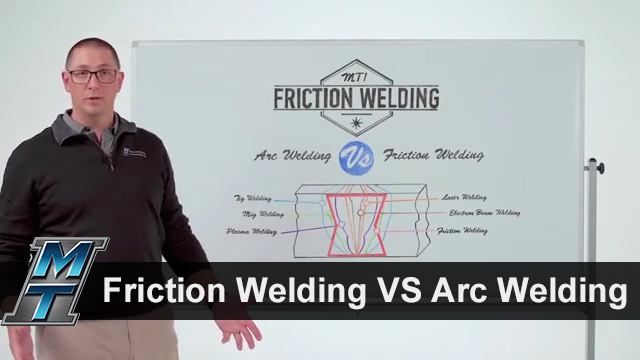
It’s withstood the test of time and is likely what you picture when you think of welding. Arc welding is undoubtedly one of the most popular ways to combine two pieces of metal.
Wait – back up. Why is MTI, the global leader in friction welding, starting this White Board Wednesday episode by complimenting a competing technology?
Well, it’s simple. There’s no denying how many industries rely on arc welding to create their products and keep their production floors humming. In fact, there are even situations where we need to use arc welding at MTI to put the finishing touch on a friction-welded part. However, there are significant, fundamental benefits to friction welding that arc welding simply cannot touch – and it all comes down to quality.
In this episode of White Board Wednesday, we will compare arc welding with friction welding and explain how these two technologies can work in tandem to optimize your next application.
WHAT IS ARC WELDING?
The most common forms of arc welding are MIG and TIG welding. In arc welding, an energy process melts filler material between two components to create a welded joint. Arc welding is considered a fusion process.
WHAT IS FRICTION WELDING?
In friction welding, one part is moved at a high speed and is pressed against another part that is held stationary. The resulting friction heats the parts, causing them to forge. During the friction welding process, parts never reach the melting point, making the weld properties superior to welds created with a fusion process such as arc welding. Because the parts never melt in friction welding, it’s considered a solid-state process.
A STRONGER SOLUTION
If a customer is currently using MIG or TIG welding, the most common reason they will approach MTI about friction welding is because they are experiencing a quality or joint strength issue. While the filler material used in MIG and TIG welding can help make the process more affordable, it can have a negative impact on the product’s overall quality and strength.
A solid-state process such as friction welding forges a part with near-parent material properties – and that’s thanks to the fact that the materials never melt during welding. A good rule of thumb when it comes to welding: the narrower the Heat Affected Zone (HAZ), the stronger the weld joint. Friction welding has a much smaller HAZ than fusion processes, providing a much higher quality weld.
SAVING TIME IN THE PROCESS
Strength isn’t the only advantage of friction welding when compared to fusion processes – it can also be a much quicker technology.
Take hydraulic cylinder rods for example. Those are typically joined with submerged arc welding… but it requires multiple passes to weld the eye to the bar. With friction welding, the weld can be complete in a matter of seconds due to the solid-state joint, part repeatability and good tension strength throughout the component.
TWO IS BETTER THAN ONE
As we mentioned toward the beginning of this episode, there are situations where we may need to combine friction welding with arc welding. For example, if we are joining an axle component at our Manufacturing Services location, we may utilize arc welding to add brackets to the part. Knowing the strengths and limitations of each welding technology – plus knowing how they can complement each other – makes MTI the ideal partner for your joining needs.
THE NEXT STEPS
If you are interested in seeing how friction welding could help improve the strength and overall quality of your fusion-welded part, contact us today to begin the conversation and to learn more about all the friction welding technologies MTI offers.
Also, check out the rest of our White Board Wednesday series to explore additional benefits of friction welding.
 MTI UK
MTI UK  FWT
FWT